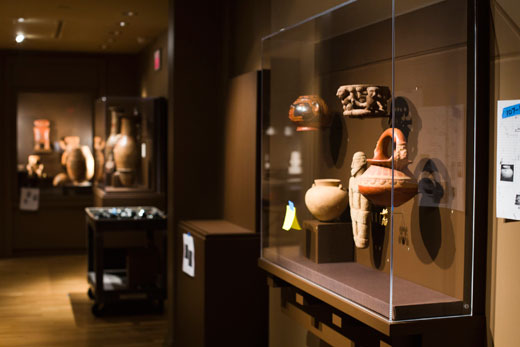The reinstallation of the Michael C. Carlos Museum's Art of the Americas galleries in the new year continues to yield new information and events.
Included for the first time in the newly renovated galleries are several egg-shaped vessels known as "womb pots," because they are thought to represent fallopian tubes.
Scheduled to run throughout 2013, the first gallery rotation of native North American art features a collection of modern Southwestern ceramics, a promised gift to the museum from Emory Art History Department chair Walter Melion and John Clum. Clum is professor emeritus of English and theater studies at Duke University.
The collection, "Walking in the Footsteps of Our Ancestors: The Melion-Clum Collection of Modern Southwestern Pottery" includes a large case of objects made by the Quezadas, a famous family of potters from Mata Ortiz, Mexico. Also featured is the museum's stunning black-on-black vessel signed by Pueblo pottery artists Maria and Julian Martinez.
Melion says that about a third of the collection that he and Clum started about 20 years ago is currently on view at the Carlos.
"When we discovered that Professor Rebecca Stone, as part of her reinstallation of the Ancient American collections, was going to devote one of the galleries to Native American art, we approached her to ask whether she'd be interested in displaying anything from the collection," he explains. "We were delighted when she decided to draw solely from our pots for the first installation.
"We see our collection as an excellent complement to the museum's holding in Ancient American ceramics," Melion says.
Looking east
And art from the eastern hemisphere gets the spotlight with two of the Carlos Museum's newest items, the elephant-headed India deity Ganesha, and an 18th-century miniature painting, illustrating a scene from the Ramayana, one of India's greatest epic poems.
Ganesha, known as the "remover of obstacles," is seated on a lotus throne, his head framed by lotus petals. His four hands hold an axe for removing obstacles in the lives of his followers; a mala or prayer beads, used in meditation; a bowl of sweets; and his broken tusk.
Emory religion professor Joyce Flueckiger will introduce Ganesha on Thursday, April 18 in a lecture titled "Removing All Obstacles: The Worship of Ganesha in India." Her talk will be at 7:30 p.m. in the Carlos Reception Hall.
The 18th-century miniature painting, heightened with gold on paper, depicts three major figures in Hindu mythology: Rama, his brother Lakshmana, and Hanuman, his devotee. In the scene in the painting, Lakshmana tenderly removes a thorn from Rama's foot as the latter steadies himself, his hand upon Hanuman's shoulder.
Carlos Museum director Bonnie Speed says, "The museum hopes to build a significant collection of Indian miniature paintings, specifically of scenes from the Ramayana, as a resource for Emory's departments of Religion, Middle Eastern Studies, and South Asian Studies."
On Tuesday, April 23, at 7:30 p.m., Peter Lacovara, the Carlos Museum's curator of Egyptian, Nubian and Near Eastern Art, will participate in a panel discussion about his book "Ancient Nubia: African Kingdoms on the Nile," recently published by the American University in Cairo Press.
Lacovara, photographer Chester Higgins, Jr., Marjorie Martin Fisher of the University of Michigan, and Egyptologist Sue D'Auria, will discuss their collaboration on the book. A book signing will follow the discussion, being held in the Carlos Reception Hall.
Nubia's remote setting in the midst of an inhospitable desert, with access by river blocked by impassable rapids, has lent it not only an air of mystery, but also isolated it from exploration.
Lacovara says, “This book is a testament to the commitment of many in our field to share the history and culture of ancient Africa. Ancient Nubia was the birthplace of many important kingdoms and the cradle of the pharaohs' Egypt. Both recent excavations and new studies of earlier discoveries have offered us a better understanding of the uniqueness and significance of this lost land.”
From Africa to the Middle East, a highlight of upcoming redesign of the Near Eastern Galleries is a relief of an Assyrian winged deity from the Palace of Ashur-Nasir-Pal ii in modern-day Iraq. The object is on loan to the Carlos Museum from the Near East Collections of the Penn Museum at the University of Pennsylvania and will be on view starting in June.
Richard Zettler, chair of the University of Pennsylvania's Department of Near Eastern Languages and Civilizations and associate curator-in-charge of the Penn Museum's Near East Collections, will give a talk on the winged deity on Thursday, May 2 at 7:30 p.m. in the Carlos Reception Hall.

